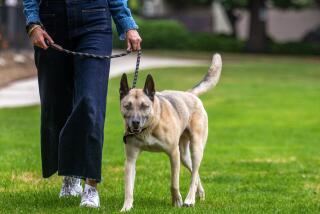Animal Behaviorist: It’s a Dog’s Life : ‘It’s Best If You’re Down at (Their) Level,’ Therapist Says
- Share via
WASHINGTON — “I know how hard it is to pick up the telephone and say, ‘I need help,’ ” the therapist says soothingly, jotting notes in his book, a cup of coffee cooling before him.
The room is quiet, the air still. The patient, with a case of sporadic trauma, scratches his ear and closes his eyes.
“He’s just using attention-getting techniques,” the therapist continues, explaining the Old English sheep dog’s indiscriminate relieving pattern to his nervous owner. “Mommy went away, he acted up, Mommy came back. He figures it worked. That’s normal.”
They call him the doggie shrink--for good reason.
“When I go into the home for family-counseling, I become the dog,” said Lloyd Aguero, director of the Reston Companion Dog Training School and, for the last two years, an animal behaviorist.
Although outrageously spoofed in the movie “Down and Out in Beverly Hills,” the profession is regarded with defiant sobriety by its practitioners.
In a situation that in less enlightened times called for a rolled-up newspaper, Aguero will speak of “desensitizing aggression,” “examining the total chemistry of the environment” and “maintaining a profile of consistency.”
And when a dog’s sanity is at stake, Aguero must especially rely on his quick perceptions.
‘Compressed Into Cubicle’
“When I entered (one owner’s) apartment,” Aguero said, “I recognized intuitively that her dog’s mind had been compressed into a small cubicle within his behavioral profile, and that he was depressed and morose about his existence. I am able to read this very quickly.”
His knowledge, he said, comes from 20 years of “self-schooling through continuing education.” He is also a member of Delta, the National Society of Animal Behaviorists, dedicated to exploring the chemistry of human-animal bonding.
“It is a multidisciplinary group,” he said. “We have psychologists, psychiatrists, doctors of veterinary medicine, registered nurses, animal behaviorists, social workers, medical doctors--people who are interested in how animals relate to people.”
Headquartered in Washington state, Delta has been in existence for four years and counts approximately 1,000 members.
Yet for all their diligence and expertise, it is still impossible to number the animal behaviorists in the country today, as they are not, as yet, licensed.
“I do not carry a degree in animal behavior. No one does,” Aguero said. “One might have a DVM, a doctorate of veterinary medicine, and then go on to study animal behavior. Some have a degree in neurobiology or neuroanatomy.”
What You Think You Are
“You are an animal behaviorist when you think you’re an animal behaviorist,” said Leo Bustad, president of Delta and professor and dean emeritus of Washington State University’s College of Veterinary Medicine. “Just like how you can call yourself a consultant when you want to be. It is when others recognize you as such.”
Aguero is called in for a variety of behavioral problems: shyness, destructive tendencies, house-breaking “accidents.” And he, in turn, recommends a variety of solutions: training programs, at-home family counseling sessions, even drug therapy.
“Dogs don’t have the brain capacity to be logical,” he said. “That’s where behaviorists come in. Behaviorists bridge the gap between dogs and humans.”
With a swoop, he is down on his knees, muzzle to muzzle with his patient. “It’s best if you’re down at his level. Do not look directly at him. That’s confrontation in their minds.”
Aguero first experienced a breakthrough in his understanding of dogs in 1965, when he started his training school. “I found that each dog was a separate behavioral entity, and that it is impossible to take dogs at large and screw them all into one training system. The training system has to be shaped to each dog-and-owner team.”
Today he charges $30 to $45 an hour for private therapy. A session of behavioral evaluation and family counseling can run from 1 1/2 to 2 hours--how long it takes, he said, to develop “the total chemistry of environment in which the dog and the owner interact.”
Puppy Anchor
“Once I understand that profile, then I’m able to develop options for the owner to modify the behavior of the animal.”
Dorie Hotis, owner of Little Soir and Gus, two of Aguero’s patients, recommends him. “With animals, Lloyd is an anchor,” she said. “That was essential to our puppies, because fear was such a debilitating factor. He could tune in with that need. We and the puppies could sense it and respond.”
Surprisingly, it is more complicated and time-consuming to bring out a shy and reticent dog than it is to desensitize an aggressive one.
“The introvert dog has to be brought out of the box into which it has closed itself,” Aguero said. “Progressive, systematic, approximation-therapy training would be involved to create a weak signal for the dog to become accustomed to and become more comfortable in the situation that is frightening. The same system is used by mental-health therapists in assisting people to overcome their fear of flying or riding in an elevator.”
Aggressive behavior, on the other hand, “just takes physical coordination, timing and strength.”
And how can you tell if you have a shy dog? “They do not like to be touched. Instead of coming up and greeting you, they roll their eyes and hide.”
Shy dogs, however, are dangerous, as they are inclined to bite. Aguero calls this fear-induced aggression.
Supplement to Therapy
He strongly suggests his 10-week training program--in which dogs are taught to sit, walk by the owner’s side, lie down, accept touch by a stranger, come when called, and socialize through the group--as a supplement to private therapy.
“This training program for dogs is just like group therapy for people,” Aguero said. “In the training program a dog learns self-confidence. He learns to integrate with both dogs and humans.”
However, the program is not for everyone. “Many times it is not the answer, because the stress level is too heavy or too intense for the dogs.”
At the end of the session, Aguero stood up, pocketed his notes and scratched his patient behind the ears.
“People react to what I do with puzzlement,” he said. “They are puzzled that the ability to get inside of an animal’s mind and become part of its senses is my skill. And they are uncomfortable with that.
“They look at me as some kind of sorcerer-type of person, and they have a built-in denial that I have this skill.”






